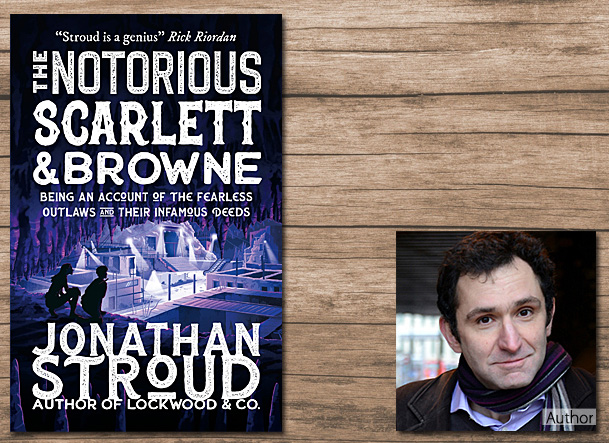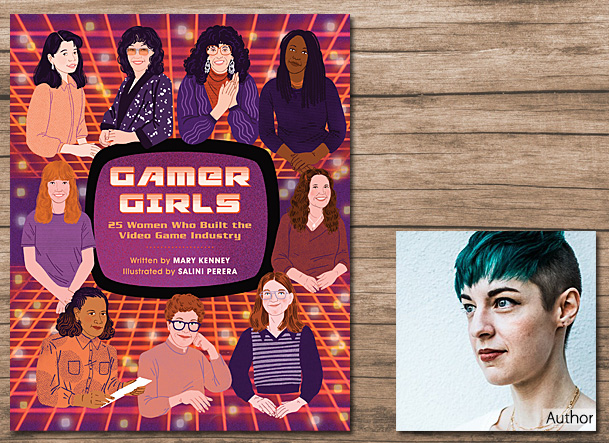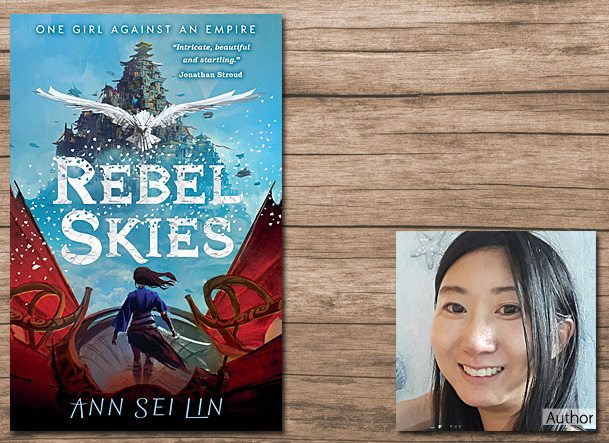In this month’s Between the Bookends, Sophie and Scott look at five books they read in June including contemporary middle grade, fantasy YA, and a non-fiction look at the history of women in video games.
Please note: This post contains affiliate links. Author/illustrator images are credited to themselves.

If You Read This by Kereen Getten (Read by Sophie)
Middle-grade books are often some of the best at tackling complex emotional topics, and If You Read This by Kereen Getten is no exception. This surprisingly deep middle-grade story follows 12-year-old Brie who lives with her family on the outskirts of a tourist resort in Jamaica. Her father, who manages the resort, has been distant with Brie ever since the death of her overly free-spirited mother three years before, leaving Brie largely in the care of her grandmother and resentful of the resort that steals away all her father’s time.
On her 12th birthday, Brie receives a gift left for her by her mother before her death: a box filled with a number of letters that will send her on one final treasure hunt, something she and her mother would do often before she fell ill. Initially hopeful that her father will accompany her on the hunt that involves going to a special place the family once frequented, Brie fears her hopes will be dashed once again. But with support from her closest friends and her remaining family, Brie is determined to follow her late mother’s clues and find out exactly what they are leading her to.
If You Read This is a very fast-paced book at just over 200 pages and, unfortunately, this means that what could have been a brilliant story doesn’t really get the time it needs to shine. Everything feels just that little bit too hurried and the sense of adventure ends up being stripped away because of this. Even the special secret at the end of the treasure hunt, a secret that supposedly took another character years to find, is discovered within a matter of hours in order to advance the plot and rush toward the ending.
However, all that being said, I did enjoy If You Read This a whole lot. Despite minimal time on the page every character really gets to shine, from Brie’s grumpy grandmother to her playful and occasionally immature uncle. There’s a wonderful subplot about the effects of dementia and how they can play out in the eyes of younger family members who often feel left out and confused about what is happening to beloved older relatives, and the subject of Brie’s mother is handled sensitively and lovingly. This story is set three years after her death, long enough for the casseroles and offers of help to have dried up, but still recent enough for the pain to feel ever-present, and Brie clearly feels lost—especially with the distance she now feels from her father.
If You Read This is a short yet powerful story, but I would be cautious about recommending it to all readers based on its subject matter. Approach this one with caution, but, in the right hands, this could be exactly the cathartic read someone desperately needs.

All Our Hidden Gifts by Caroline O’Donoghue (Read by Sophie)
When Maeve is assigned to clear out an old cupboard at her Irish Catholic girls’ school at the beginning of All Our Hidden Gifts by Caroline O’Donoghue, she discovers an unusual set of tarot cards. Finding herself strangely drawn to the deck, Maeve—until then something of an outcast—begins to give readings and quickly gains popularity thanks to her astute readings. However, when Maeve’s former best friend Lily is pressured into having a reading, she draws the unsettling Housekeeper card. Unsure of its meaning, an argument breaks out between the girls resulting in Maeve wishing that Lily would disappear. When Lily doesn’t turn up to school on Monday, Maeve quickly realizes that her wish has come true.
Meanwhile, a homophobic hate group calling themselves the Children of Brigid has begun showing up around town. Led by their suspiciously charming and coercive leader Aaron, the group protests outside a local store that sells alternative clothes and later physically attacks Maeve’s older sister Jo and her girlfriend. As more weird events start happening—huge snow flurries shut down the town while tropical fish appear in the river—Maeve begins to suspect she might be the cause of it all. Teaming up with Lily’s non-binary sibling Roe (with whom she is developing a mutual attraction) and her new friend Fiona, Maeve tries to track down who the Housekeeper really is and what she might have done with Lily.
All Our Hidden Gifts was a brilliant story that brought together many of my favorite elements in YA, primarily numerous queer characters and supernatural/witchy vibes. I loved having a main character in a book who struggles academically rather than being a genius. Maeve is in the slow-readers group and finds school challenging—something even more galling when she compares herself to her family who is all academically talented with PhDs and Masters degrees. The tarot card meanings come naturally to Maeve in a way she has never experienced before, creating a powerful bond between her and the cards that quickly grows out of control.
The story also brings in a huge amount of Irish culture, considering the many ways in which the country has rapidly changed in recent decades and how this has brought about divisions. Once a devoutly Catholic nation, Ireland has now legalized divorce and same-sex marriage, among others, leading to a new generation growing up surrounded by history very different from their present. This is largely explored through Roe as a non-binary character and Jo’s experiences as a lesbian, but the book also looks at the impact of historic events such as a failed attempt to legalize divorce in 1989 and the repercussions of that vote in the community. One final thing I wanted to applaud was the book’s resolution. This is book one of a series, but I loved how Lily’s plotline was resolved and the discussions had about forgiveness and personal choice. Maeve is initially surprised by how events turn out in the end, but I appreciated the discussions of how nobody owes you anything, especially not forgiveness, and that one good deed does not instantly erase a history of bad ones.
I’m already excited to pick up the next book in this series–The Gifts That Bind Us—and hope it continues on in a similar style.

The Notorious Scarlett and Browne by Jonathan Stroud (Read by Scott)
The Notorious Scarlett and Browne is the second of a new trilogy by Jonathan Stroud, the author of the brilliant Bartimaeus and Lockwood & Co. series of books. Set in a future England following a cataclysmic event, this new series follows outlaws Scarlett and Browne. Scarlett McCain is fast with both a gun and her mouth, while Albert Browne is innocent and naive but with devastating mental powers.
Set six months after the first book, the fame and notoriety of the pair have risen to new heights as they undertake daring robberies and heists while continuing to evade capture by the authorities and Faith Houses. However, the past soon catches up with them during a failed job, and they are forced to take on an impossible mission to save those they care for the most. While they do, a new formidable adversary tracks them across the country, one even Scarlett and Browne struggle to cope with and who forces Albert to confront his greatest fear.
The first novel contained flashbacks of Albert’s life, revealing his history and escape from the asylum he was kept in along with his mysterious powers. This book gives flashbacks for Scarlett, fleshing out her back story and giving some context and substance to her behavior, bravado, and defensiveness, and giving her more nuance beneath the hard exterior, showing there is more to this teenage anti-hero than her tough girl image suggests. Both Scarlett and Browne are engaging characters in their own way, and you can’t help but root for them during the series of scrapes and misadventures they get into.
Once again, the plot and story move at pace with wit and humor. Although heavily influenced by and aping the American Wild West, this is a distinctly British book with its settings, characterizations, witticisms, dialects, and language. There are plenty of laugh-out-loud moments alongside rip-roaring action, thrills, and danger. Stroud gives plenty of descriptive narrative about the ravaged landscape and how England is left with isolated settlements, strange and dangerous animals, and the Tainted—zombie-like humans who are spreading across the land and striking terror into the hearts of the remaining population—but it is still little about what has caused this devastation though that may get covered in the next volume.
Anyone who enjoyed the first book in the series plus Stroud’s previous novels will find plenty to love in this second adventure. While not yet hitting the immense heights of his previous series, Scarlett and Browne is proving to be a highly entertaining adventure romp that should keep readers engrossed and turning to the next page for many hours. I will be waiting with bated breath for the final book in the series.

Gamer Girls: 25 Women Who Built the Video Game Industry by Mary Kenney (Read by Sophie)
As far back as I can remember, I have played video games. My first gaming memories are of clicking colorful shapes on simple programs written for me by my dad in the late 1980s, but across the dozens of computers and consoles I have used over the years, I have always identified as a woman who plays games. Gamer Girls: 25 Women Who Built the Video Game Industry by Mary Kenney is a collection of short biographies of women who helped create the video game industry and who insisted that girls like me existed and that, yes, we want to play games too.
I’ll be honest and admit that I didn’t know a single name that was included here, although how much of that is down to me and how much is because their names simply aren’t trumpeted as loudly as male game developers like Will Wright or Sid Meier is debatable. Either way, I appreciated getting to meet so many remarkable women who worked in a range of areas within the industry, including Roberta Williams (creator of Mystery House and co-founder of Sierra On-Line), Yoko Shimomura (composer for Street Fighter II and Kingdom Hearts), Rebecca Heineman (the first national video game tournament champion), and Auriea Harvey (creator of The Endless Forest and The Graveyard). The book is laid out in a somewhat retro style with distinctive orange and purple graphics, and scattered throughout are dozens of “Side Quests” taking brief looks at even more women in gaming including Xiaoyuan Tu who helped develop the MotionPlus wireless controllers for the Nintendo Wii.
Gamer Girls does a remarkable job of covering a diverse group of women considering that game development remains to this day disappointingly homogenous. (As of a survey in 2019, more than 70% of game developers identify as male, and 81% of those who identified as female were white.) The book included many women of color and several transgender women as well, helping to dispel multiple notions of what a game developer looks like. One thing I did spot was a recurring theme in many of these biographies was a moment where the woman in question would pack her bags and head to a new city with no job lined up, simply knowing that the game studio of her dreams was based there and hopeful to get her foot in the door by any means necessary. This suggests a level of affluence among people entering the industry, as someone living without financial support would be much less able to take such an enormous gamble.
Gamer Girls is a fascinating look into the history of video game development and how the industry has been shaped by the women who worked within it. If you’ve ever played a video game, this one is worth picking up.

Rebel Skies by Ann Sei Lin (Read by Scott)
Rebel Skies is a new fantasy adventure aimed at teens by Ann Sei Lin, with heavy influence and inspiration from Japanese culture. The book falls under a genre called “silkpunk” where science fiction and fantasy are blended with elements of east-Asian mythology and antiquity.
The story is set in a world of sky cities, flying ships, strange air creatures, and papercraft, where Crafters have the ability to control paper and form it into almost anything. The Crafters hunt wild paper spirits called shikigami which roam the sky and can cause great destruction to the human population and sky cities.
Kurara is a servant aboard the Midori, a sky structure of restaurants and hotels and the only life and place she knows, and she has the ability to make paper come to life. When the Midori is attacked by a shikigami, Kurara joins a skyship that hunts the paper spirits and brings them back to the Princess, who covets Crafters and shikigami. On the skyship, she is taught how to hone her skills and power by an accomplished Crafter called Himura who promises to take her to meet the Princess.
As the story progresses it soon becomes clear that all is not as it seems. There is politics, subterfuge, and power play everywhere, and the very question of whether shikigami are really wild and free paper spirits or slaves to Crafters and the Empire. Kurara is drawn into this duplicitous world as she tries to save what matters most to her.
The world-building in Rebel Skies is beautiful and complex. Ann Sei Lin has obviously put a lot of time and thought into the world, the system of magic, and the lore of paper craft and shikigami. Themes of control and slavery run through the plot with occasional scenes of torture and imprisonment.
The story moves along at pace with exposition handled well. However, what was lacking for me was character depth. I felt I was casually observing the characters rather than being drawn in and emotionally connecting to them so that at moments of great peril or plot reveals I was not that invested in the people. However, the exquisitely built world and lore, and engaging Asian cultural influences, more than made up for this, and the flat characterization will hopefully be addressed with more backstory for the main characters and more utilization of secondary characters in the second and third books of what is a planned trilogy.
Anyone who is a fan of Studio Ghibli will find a lot to enjoy here. While aimed at teens and YA audiences, there is plenty to engage adult readers as well. Rebel Skies is a good, solid first novel with intriguing and intricately beautiful mythology which makes a refreshing change from American and European culturally influenced stories we all read much of the time.
GeekMom received copies of these titles for review purposes.




